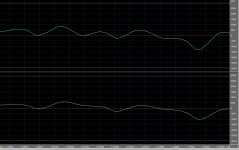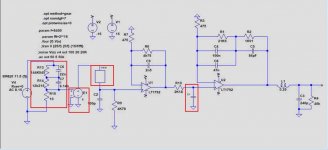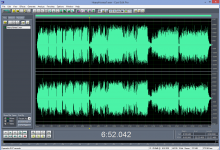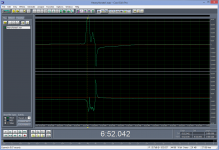Marcel, surely if you let the click and pop clip, you will generate a spray of harmonics. Some of those will be in band, but a lot above 20 kHz. If digitizing, I assume you would have to filter stuff out above 20kHz to ensure Nyqvist is satisfied. Maybe Bill has a view on this?
The 10€ LCR meter Hans has mentioned before should be good enough for the roll off. Of course you have the noise penalty (see Cordell vinyltrack and various sims Hans and Marcel did)
So, overloading ADCs inputs is something that should be strictly avoided. No intentions of further discussion.
Totally unrealistic test and not my experience at all. Here's an example from admittedly a very clean LP, a single clipping event on a full 20:30 side. Looking at the unclipped channel to estimate the length of the actual damage there is little or no evidence of A/D misbehavior. My favorite pop remover leaves no artifacts.
It worth remembering that the surface artifacts do not see RIAA pre-emphasis and when recording flat at 24bits with ~12dB of headroom allowance (to A/D full scale) pops that clip are very rare on anything but seriously damaged LP's.
I might add we have had these same conversations back and forth for years with little visual documentation supporting some of the opinions.
Attachments
Last edited:
Marcel, surely if you let the click and pop clip, you will generate a spray of harmonics. Some of those will be in band, but a lot above 20 kHz. If digitizing, I assume you would have to filter stuff out above 20kHz to ensure Nyqvist is satisfied. Maybe Bill has a view on this?
For digitizing you need an anti-aliasing filter anyway, but if you are going to digitize, it makes sense to do any declicking in the digital domain and keep the analogue part as linear as you can.
My comments about the possible advantages of clipping the clicks before RIAA correction were related to a system without any declicking further down the chain. The generation of harmonics (which get attenuated by the RIAA correction) could outweigh the advantages of the reduced click amplitude if they make the waveform more audible, but I have no idea if they do.
Totally unrealistic test and not my experience at all. Here's an example from admittedly a very clean LP, a single clipping event on a full 20:30 side. Looking at the unclipped channel to estimate the length of the actual damage there is little or no evidence of A/D misbehavior. My favorite pop remover leaves no artifacts.
It worth remembering that the surface artifacts do not see RIAA pre-emphasis and when recording flat at 24bits with ~12dB of headroom allowance (to A/D full scale) pops that clip are very rare on anything but seriously damaged LP's.
I might add we have had these same conversations back and forth for years with little visual documentation supporting some of the opinions.
Those are EXACTLY the shapes of the clicks and pops I got and corrected with Audacity.
What program did you use to correct those?
except i heard unpleasant clicks and pops only with fet input phono preamps,not with bjt input...
And this is what things are becoming when replacing the 75usec pole behind the first OPA by a lower termination resitance.
R = L/Tc = 0.46/75usec = 6k13
This 6K13 minus the 1k35 fron the Cart gives 4k783 as a termination load.
Because of this, the FR will significantly change in the HF area, so C9 will have to be increased to 2n5.
In the image below you will see again the FR without Cart mechanical resonance in red and after Cart resonance in Blue.
FR will now be practically insensitive to the input capacitance.
Hans
Hans,
Perhaps I am asking obvious questions, but I would like to understand it better.
1) Why C1 was eliminated? Isn't that the passive first stage filter?
2) V15 III group replaces L1 and R4 on my circuit?
3) Your RIAA load is better than the one I was using? Why?
Attachments
except i heard unpleasant clicks and pops only with fet input phono preamps,not with bjt input...
It is your experience and I cannot see it supported by hard data. Do you have any? In my experience there are no such issues with fet input phono preamps, namely with those I designed.
Input AC coupling makes the ADC recovery unpredictable.
All my USB sound cards and field recorders are AC coupled no problems, I could bury this thread with pictures of real LP rips either with digital RIAA or conventional RIAA. IMO this is a non-issue.
What program did you use to correct those?
I use the free ClickFix plugin for Audition/CoolEdit in single fix mode. I haven't compared it to Audacity in several years but it always had fewer artifacts in this mode. In my estimation it uses a recursive method published in an old AES paper on forensic audio restoration. Last I looked Audacity uses spectral techniques which are sub-optimal to what can be achieved.
It is your experience and I cannot see it supported by hard data. Do you have any? In my experience there are no such issues with fet input phono preamps, namely with those I designed.
Input AC coupling makes the ADC recovery unpredictable.
Not sure if you reffered to phono preamp input coupling or sound card input coupling...
My point was that fet input phono preamps are not necessarily ac coupled as most bjt input phono...I'm not insisting on the fact that all fet input preamps are prone to unpleasant treatement of clicks and pops ,but some of those based on high transconductance and high capacitance j-fets clearly are .
Last edited:
Hans,
Perhaps I am asking obvious questions, but I would like to understand it better.
1) Why C1 was eliminated? Isn't that the passive first stage filter?
2) V15 III group replaces L1 and R4 on my circuit?
3) Your RIAA load is better than the one I was using? Why?
1) 4K78 replaced the original 47K termination resistance thereby creating a 75usec pole, that was previously created in your circuit diagram by C1.
That's why C1 could be discarded. Note that this resistor is Cart dependant.
Also note that C9 was changed into 2.5nF in this specific setup.
2) yes
3)You mean the Anti Riaa network ? Quite simply because it is more accurate.
Please read the previous postings carefully, because it's all there.
See also here the three examples.
FET vs BJT input phono preamp
Hans
All my USB sound cards and field recorders are AC coupled no problems, I could bury this thread with pictures of real LP rips either with digital RIAA or conventional RIAA. IMO this is a non-issue.
Do you happen to know if hard clipping before RIAA correction makes clicks more or less audible?
1) 4K78 replaced the original 47K termination resistance thereby creating a 75usec pole, that was previously created in your circuit diagram by C1.
That's why C1 could be discarded. Note that this resistor is Cart dependant.
Also note that C9 was changed into 2.5nF in this specific setup.
Am I wrong, or what you are doing is adding a low-pass filter at the input instead of the filter between stages?
3)You mean the Anti Riaa network ? Quite simply because it is more accurate.
Where was it considered as such? Just want to know, not to question what you say.
See also here the three examples.
FET vs BJT input phono preamp
Can you upload the asc file for that simulation?
All my USB sound cards and field recorders are AC coupled no problems, I could bury this thread with pictures of real LP rips either with digital RIAA or conventional RIAA. IMO this is a non-issue.
So let's go ahead and bury this thread.
Attachments
Sorry to interrupt...what's the measurement unit on the horizontal and the vertical scale?They look like completely meaningless photos to me.If you put photos,you better explain what they really tell to people that aren't using your software on a regular basis.
So let's go ahead and bury this thread.
What are you showing, to me it looks like a 1.5ms pop (which is on the LP) and which a decent pop removal software would make inaudible. I see no A/D bad behavior here. Besides the point it looks like there is only one on the whole cut, not exactly a "sound".
Last edited:
So let's go ahead and bury this thread.
What was the bit rate and oversampling for that file?
Those files I captured, because of the ADC, were only 16/48, but the next will be done at 24/96.
So the files will be larger and resolution much better. Should be able to glitches that I couldn't get to so cleanly.
I accept any recommendations on programs I can use for this.
- Status
- Not open for further replies.
- Home
- Source & Line
- Analogue Source
- FET vs BJT input phono preamp




